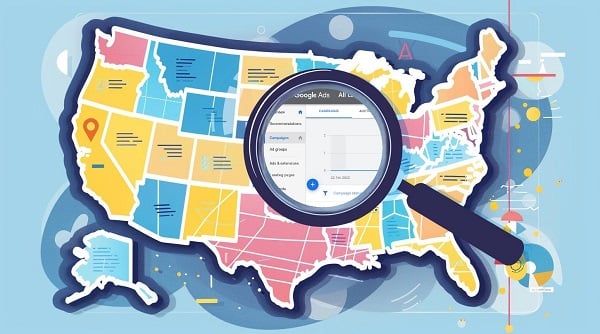SOCKS Web: Advanced Guide to SOCKS5 & Proxy Traffic Management
Deep dive into SOCKS5: byte-level handshake, DNS leak tests, cross-platform examples, and enterprise deployment tips for sysadmins and developers.
Dec 22, 2025
Learn how using residential proxies ensure accurate Google Ads verification, prevent bans, and boost ROI with GoProxy’s solutions.
On May 7, 2025, a report from eMarketer highlighted that digital ad spending in the United States is projected to surpass $300 billion in 2025, with Google Ads commanding a significant share of this market. However, the same report noted that ad fraud, including impression and click fraud, continues to drain budgets, costing advertisers an estimated $100 billion annually.
For digital marketers and ad agencies, ensuring that Google Ads campaigns are verified accurately is no longer optional; it is a critical component of maximizing return on investment (ROI). The challenge lies in navigating Google’s sophisticated anti-bot measures and geographic restrictions, which can block verification attempts or skew campaign data.
This is where residential proxies emerge as a subtle yet powerful solution, enabling advertisers to verify ad placements with precision while maintaining compliance and anonymity.
The process of verifying Google Ads involves confirming that advertisements are displayed correctly to the intended audience in specific geographic regions, free from fraudulent activity such as bot-driven clicks or hidden impressions. Without proper verification, campaigns risk wasting budgets on invalid traffic or failing to reach the target demographic.
Residential proxies, which route traffic through real user devices with IP addresses assigned by Internet Service Providers (ISPs), offer a way to simulate genuine user behavior in the United States, ensuring accurate ad audits.
This article explores the technical intricacies of using residential proxies for Google Ads verification, addresses real user needs and challenges, and provides a practical case study to illustrate implementation.

Google Ads operates within a complex ecosystem where algorithms prioritize user relevance and campaign authenticity. Advertisers must verify that their ads appear as intended across various devices, locations, and platforms.
This task becomes complicated when verification attempts are flagged as suspicious due to repetitive requests from a single IP address or the use of datacenter-based IPs, which Google’s anti-bot systems often detect.
Residential proxies address this by providing IP addresses tied to real residential devices, making verification requests indistinguishable from organic user traffic.
The technical advantage of residential proxies lies in their authenticity. Unlike datacenter proxies, which originate from server farms, residential proxies use IPs assigned by ISPs, simulating the behavior of a typical household user and more suitable in this case.
For example, a digital marketer in New York can use a residential proxy to emulate a user in Los Angeles, verifying whether a Google Ad appears correctly for a West Coast audience. This geo-targeting capability is critical for campaigns tailored to specific U.S. regions, where ad placement and visibility can vary significantly.
Moreover, residential proxies support IP rotation, a feature that cycles through different IP addresses to prevent detection. Google’s CAPTCHA triggers and rate-limiting mechanisms are designed to block bulk requests, but rotating residential proxies ensure that each verification request appears to come from a unique user. This reduces the risk of IP bans and allows for large-scale auditing without interruptions.
For developers, integrating residential proxies into verification workflows involves configuring proxy settings in scraping tools or automation scripts, a process that requires attention to rotation frequency and session management.
Implementing residential proxies for Google Ads verification is not without challenges. Developers must contend with Google’s JavaScript rendering requirements, introduced in January 2025, which mandate that verification scripts process dynamic content to access ad data.
Additionally, anti-bot defenses such as reCAPTCHA and Cloudflare can disrupt automated verification, especially if proxies are misconfigured. Below is a detailed explanation of how to address these challenges and implement GoProxy’s residential proxies effectively.
For Google Ads verification, residential proxies are the preferred choice due to their low detection rates.
GoProxy is a proxy server provider that offers a pool of over 90 million residential IPs across 200+ countries, with robust U.S. coverage. These proxies support HTTP, HTTPS, and SOCKS5 protocols, ensuring compatibility with most verification tools. Includes a 7-day trial for platform testing, automatically renewed monthly during the trial period. Sign up to get it today!
Developers should prioritize rotating residential proxies for tasks requiring frequent requests, as they automatically cycle IPs to avoid detection.
For campaigns needing consistent IP addresses, such as those verifying session-based ad interactions, sticky residential proxies maintain the same IP for up to 60 minutes.
| Proxy Type | Use Case | Advantages | Considerations |
| Rotating Residential Proxies | Bulk ad verification, SERP scraping | High anonymity, low CAPTCHA triggers | Requires configuration for rotation frequency |
| Sticky Residential Proxies | Session-based ad verification | Consistent IP for prolonged tasks | Less frequent rotation may increase detection risk |
| Mobile Proxies | Mobile ad verification | Simulates mobile carrier IPs | Higher cost, specialized use |
To integrate GoProxy’s residential proxies, developers can use tools like Python’s requests library or scraping frameworks such as Scrapy. Below is a sample Python script demonstrating how to set up a rotating residential proxy for Google Ads verification:
<xaiartifact artifact_id="3753bad6-dd2e-48c7-8a93-75fc08b217e5" artifact_version_id="5773cb44-0ff4-4a25-a95a-d3f932721170" title="Python Script for Proxy Configuration" contenttype="text/python"> import requests from pprint import pprint <h1>GoProxy credentials</h1> <p>proxy_user = "your_username" proxy_pass = "your_password" proxy_endpoint = "proxy.goproxy.com:8080"</p> <h1>Proxy configuration</h1> <p>proxies = { "http": f"http://{proxy_user}:{proxy_pass}@{proxy_endpoint}", "https": f"http://{proxy_user}:{proxy_pass}@{proxy_endpoint}" }</p> <h1>Verification request</h1> <p>url = "<a href="https://www.google.com/search?q=test+ad">https://www.google.com/search?q=test+ad</a>" headers = { "User-Agent": "Mozilla/5.0 (Windows NT 10.0; Win64; x64) Chrome/114.0.0.0" }</p> <p>try: response = requests.get(url, proxies=proxies, headers=headers) if response.status_code == 200: pprint(response.text) else: print(f"Request failed with status code: {response.status_code}") except Exception as e: print(f"Error: {e}")</p></xaiartifact>
This script configures a residential proxy to send a request to Google’s search results page, simulating a user query.
Developers must replace your_username and your_password with their GoProxy credentials. To handle JavaScript rendering, tools like Selenium or Puppeteer can be paired with residential proxies to process dynamic ad content.
Google’s anti-bot measures often flag repetitive requests from the same IP. GoProxy’s residential proxies offer a Time-to-Live (TTL) feature, allowing developers to set rotation intervals between 3 and 30 minutes.
For high-anonymity tasks, a shorter TTL (e.g., 3-5 minutes) minimizes tracking risks. For session continuity, such as verifying multi-step ad interactions, a longer TTL (e.g., 20-30 minutes) ensures the same IP is used throughout the session. Developers can adjust these settings via GoProxy’s dashboard, which provides granular control over rotation frequency.
Google’s CAPTCHA triggers can disrupt verification, especially during bulk requests. GoProxy’s residential proxies reduce CAPTCHA occurrences by using real user IPs, but developers should implement fallback mechanisms.
For instance, integrating CAPTCHA-solving services or throttling request rates can maintain workflow continuity. A practical approach is to limit requests to 1-2 per second per IP, distributing verification tasks across multiple residential proxies.

The use of residential proxies in Google Ads verification is not merely a technical workaround; it represents a strategic shift toward precision and accountability in digital advertising. The ability to emulate real user behavior across diverse U.S. regions empowers marketers to uncover insights that would otherwise be obscured by geographic or anti-bot barriers.
What sets GoProxy apart is its emphasis on user control, from customizable rotation intervals to a vast IP pool that supports even the most demanding verification tasks. This flexibility allows developers to tailor solutions to specific campaign needs, whether verifying a single ad in a niche market or auditing thousands of impressions nationwide.
One underappreciated aspect of residential proxies is their role in ethical advertising. By ensuring ads reach genuine audiences, proxies help advertisers uphold campaign integrity, aligning with Google’s push for transparency. This alignment not only boosts ROI but also builds trust with clients who demand verifiable results.
For developers, the challenge lies in balancing automation with authenticity, ensuring that verification scripts mimic human behavior without triggering defenses. GoProxy’s intuitive dashboard and robust support simplify this process, making it accessible to both seasoned engineers and marketing teams.
Residential proxies use real ISP-assigned IPs, making requests appear as organic user traffic. GoProxy’s rotating proxies cycle IPs frequently, reducing the risk of detection by Google’s anti-bot systems. Developers can set rotation intervals to minimize repetitive requests from a single IP.
GoProxy supports integration with tools like Scrapy, Selenium, and Puppeteer, which handle JavaScript rendering and dynamic ad content. The proxies’ HTTP, HTTPS, and SOCKS5 compatibility ensures seamless setup with most scraping frameworks.
Google’s January 2025 update requires scripts to process JavaScript for ad data access. Pairing GoProxy’s residential proxies with headless browsers like Puppeteer allows developers to render dynamic content while maintaining anonymity.
For high-anonymity tasks, a 3-5 minute TTL is ideal to avoid tracking. GoProxy’s TTL feature allows customization, balancing anonymity with session continuity based on campaign needs.
GoProxy offers flexible pricing with a 7-day trial, allowing agencies to test proxies without upfront costs. The high success rate and reduced fraud losses make residential proxies a cost-effective solution for campaigns of all sizes.
Verifying Google Ads with precision have become important to ensure campaign success. Residential proxies provide a subtle yet effective solution, enabling marketers and developers to navigate Google’s anti-bot defenses, ensure accurate ad placements, and maximize ROI.
GoProxy’s vast IP pool, customizable rotation settings, and robust support empower users to implement verification workflows with confidence.
By addressing technical challenges and aligning with real user needs, residential proxies transform ad verification from a hurdle into an opportunity for growth.
Sign up for GoProxy’s Residential Proxies trial to verify ads today and unlock the full potential of Google Ads campaigns.
< Previous
Next >
 Cancel anytime
Cancel anytime No credit card required
No credit card required